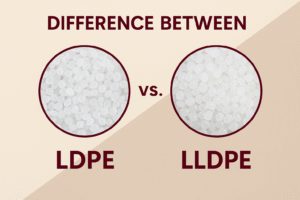Introduction
 In today’s world, plastics play a vital role in almost every industry – from packaging and agriculture to construction and consumer goods. Among the many polymers available, Low-Density Polyethylene (LDPE) and Linear Low-Density Polyethylene (LLDPE) are two of the most widely used. While both fall under the polyethylene family, their properties, applications, and cost-effectiveness can vary significantly.
In today’s world, plastics play a vital role in almost every industry – from packaging and agriculture to construction and consumer goods. Among the many polymers available, Low-Density Polyethylene (LDPE) and Linear Low-Density Polyethylene (LLDPE) are two of the most widely used. While both fall under the polyethylene family, their properties, applications, and cost-effectiveness can vary significantly.
If you are a manufacturer, distributor, or business decision-maker, understanding the differences between LDPE and LLDPE will help you make an informed choice for your products and operations. In this blog, we’ll break down the key characteristics, advantages, disadvantages, and applications of each, so you can decide which polymer best suits your needs.
What is LDPE (Low-Density Polyethylene)?
LDPE is one of the oldest and most commonly used polyethylene types. It is created through a high-pressure polymerization process, which gives it a highly branched molecular structure. This branching results in its characteristic softness, flexibility, and clarity.
Key Features of LDPE
- Excellent flexibility and toughness
- Lightweight with good impact resistance
- High transparency, making it suitable for packaging films
- Good moisture resistance
- Easy to process and low-cost production
Common Applications of LDPE
- Plastic bags and grocery sacks
- Agricultural films and greenhouse coverings
- Food packaging materials
- Wire and cable insulation
- Toys and lightweight containers
LDPE is ideal where clarity, flexibility, and cost-effectiveness are important.
What is LLDPE (Linear Low-Density Polyethylene)?
LLDPE is a newer variant of polyethylene, introduced to address some limitations of LDPE. It is manufactured through low-pressure polymerization with comonomers, giving it a linear structure with short side branches. This molecular structure provides improved mechanical properties compared to LDPE.
Key Features of LLDPE
- Higher tensile strength than LDPE
- Greater puncture and impact resistance
- Better stress-crack resistance
- Excellent flexibility at thinner gauges
- Cost-efficient due to downgauging potential (thinner films with equal strength)
Common Applications of LLDPE
- Stretch films and cling films
- Industrial liners and geomembranes
- Heavy-duty bags and sacks
- Pipes and tubing
- Agricultural mulch films
LLDPE is preferred in applications that demand durability and strength.
LDPE vs. LLDPE: A Side-by-Side Comparison
| Property | LDPE | LLDPE |
|---|---|---|
| Molecular Structure | Highly branched | Linear with short branches |
| Flexibility | Very flexible | Flexible but stronger |
| Strength | Moderate strength | High tensile & impact strength |
| Transparency | High clarity | Lower clarity |
| Processing Ease | Easy to process | Requires advanced processing |
| Cost Efficiency | Cost-effective for simple uses | Better value in heavy-duty uses |
| Best For | Lightweight, transparent films | Heavy-duty, durable applications |
Advantages and Disadvantages of LDPE
✅ Advantages:
Lightweight and flexible
Excellent clarity for packaging
Moisture-resistant
Cost-effective and easy to process
❌ Disadvantages:
Lower strength and durability compared to LLDPE
Poor resistance to stress cracking
Limited use in high-load applications
Advantages and Disadvantages of LLDPE
✅ Advantages:
High tensile and impact strength
Superior puncture and crack resistance
Can be used in thinner gauges, saving costs
Versatile for heavy-duty industrial uses
❌ Disadvantages:
Lower transparency compared to LDPE
More difficult to process (requires modern equipment)
Slightly higher initial cost than LDPE
Which Polymer Should You Choose – LDPE or LLDPE?
The choice between LDPE and LLDPE ultimately depends on your application requirements:
Choose LDPE if:
- You need clarity and flexibility
- Applications are lightweight and not stress-intensive
- Cost-effectiveness is your primary concern
- Ideal for packaging films, bags, and wraps
Choose LLDPE if:
- You need strength, durability, and toughness
- Applications involve heavy loads or require puncture resistance
- You want long-lasting performance under stress
- Perfect for industrial liners, stretch films, and heavy-duty packaging
In many industries, LDPE and LLDPE are even blended together to achieve a balance of clarity, flexibility, and strength. This hybrid approach allows manufacturers to take advantage of the best properties of both materials.
Sustainability Aspect
Both LDPE and LLDPE are recyclable polymers under recycling code #4. With the growing demand for eco-friendly solutions, businesses are increasingly focusing on recycling, reprocessing, and sustainable sourcing. At ISHA EXIIM, we emphasize the supply of recyclable grades that help manufacturers meet environmental compliance while maintaining quality.
Conclusion
When deciding between LDPE and LLDPE, consider the balance of clarity, flexibility, durability, and cost that your application requires. LDPE works best for lightweight and transparent packaging, while LLDPE excels in heavy-duty and industrial applications. By making the right choice, you not only improve the performance of your products but also ensure cost-efficiency and customer satisfaction.
At ISHA EXIIM, we offer a wide range of LDPE and LLDPE grades tailored for various industries. With 15+ years of expertise in domestic and international trade, we ensure quality, consistency, and timely delivery worldwide.
FAQs
1. Is LLDPE stronger than LDPE?
Yes, LLDPE has higher tensile strength and better puncture resistance than LDPE, making it suitable for heavy-duty applications.
2. Which is cheaper: LDPE or LLDPE?
LDPE is generally cheaper, but LLDPE can offer better value in the long term because of its strength and downgauging potential.
3. Can LDPE and LLDPE be recycled?
Yes, both are recyclable under recycling code #4. Their recyclability depends on local recycling infrastructure.
4. Can LDPE and LLDPE be blended?
Yes, blending LDPE with LLDPE combines flexibility, strength, and clarity, offering balanced performance.
5. Which industries use LLDPE the most?
Industries such as packaging, agriculture, construction, and logistics use LLDPE extensively for films, liners, and heavy-duty bags.
